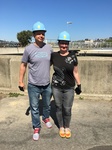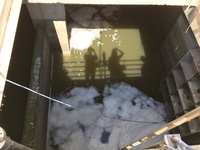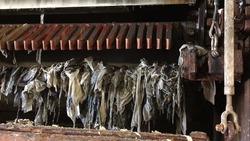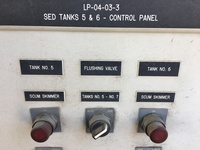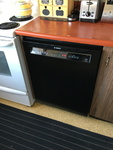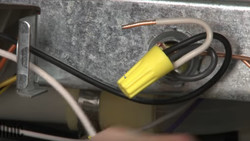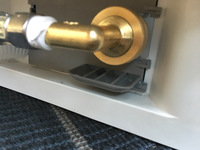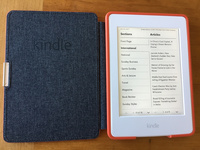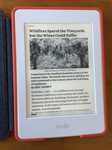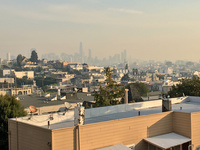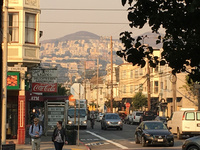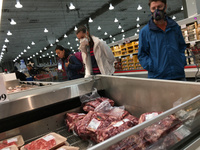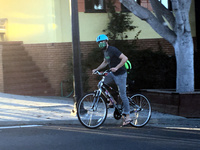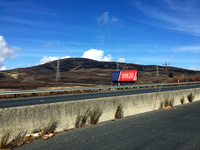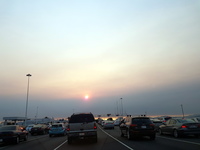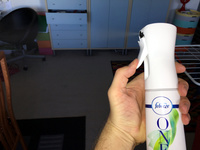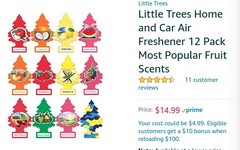 |
| Angelika/Mike Schilli |
|
|
Michael What happens after we flush the toilet? To find out, we booked a tour of the "San Francisco Public Utilities Commission Wastewater Treatment Plant" in the Bayview district at the end of August. Promptly at 9:45 on a Saturday morning, we had to report at the visitor entrance wearing long pants and closed shoes (!), and after an hour of theory, we were immediately equipped with helmets and latex gloves.
San Francisco has what's called a "combined sewer system," which means it directs toilet flushes and other household wastewater together with rainwater that runs into the sewers through the same pipe to one of the city's three wastewater treatment plants.
There, machines first filter out non-decomposable parts from the wastewater, and we were informed that so-called "flushable wipes," or wet toilet paper, contrary to what the packaging claims, do not decompose in the wastewater. Instead, they are fished out at the sewage treatment plant along with other solids by large rakes and stored in a landfill.
What remains is foul-smelling brackish water redolent of excrement, whose sludge content slowly settles to the bottom, where it is then removed and chemically thickened until it has about the consistency of hot asphalt. It is subsequently used as fertilizer on fields where no food is grown. The water is then further purified by microorganisms, disinfected with chlorine, and pumped out through a pipe extending about 50 meters into the San Francisco Bay. About 80% of San Francisco's wastewater is thus returned to the cycle, with the remaining 20% undergoing a similar process (but without chlorine) into the Pacific Ocean.
Americans often affectionately refer to excrement as "Poop" or "Number Two" or "#2". The latter is used so that little kids can differentiate between pee ("Number One") and poop ("Number Two"). The slogan of the sewage treatment plant was quite catchy, proclaiming that the brown sludge from the sewer is the city sewage plant's top priority, as, right? "Your #2 is our #1", which was actually emblazoned on stickers that workers proudly wore on their helmets.
During heavy rain, especially in surrounding cities with smaller facilities like Pacifica, it can happen that the sewer pipes and the additionally installed catch basins fill up, and then there's no time left to clean the sludge, which then goes directly into the Pacific Ocean without further ado. This also explains the warning signs that appear on the beach after heavy rains, prohibiting swimming. I've always wondered where that came from. Of course, the surfers there don't take any notice of warning signs; come what may, they go into the water, as the waves don't surf themselves.
Michael Recently our old washing machine gave up the ghost. In America, the landlord is responsible for providing replacement kitchen appliances if they break down, but since ours would have undoubtedly been replaced with another noisy, low quality appliance that makes you think the door's open and it's impossible to entertain guests or even watch TV while it's running, we decided to bite the bullet and buy a quiet Bosch dishwasher. Its customer reviews on Amazon weren't exactly mind-blowing, but German products have gone downhill in quality and nowadays have pretty bad reputation in America (just like German cars that often sit in repair shops), so what can you do? We were just hoping for the best.
The new dishwasher was delivered by two strong men who hardly spoke English, and upon my request, it was not installed by professional personnel because I wanted to do it myself to save the $150 which it would have cost extra otherwise. Who would have thought I'd learn some things for life in the process! Fortunately, there are plenty of hobby craftsmen on YouTube who show how to connect the power cable and the water supply pipes, so that part was pretty straightforward.
In America, dishwashers are usually only connected to the power grid using screw clamps like in Figure 10. In many residences, there is only a cable coming out of the wall under the sink, and after the plumber has pushed the dishwasher into its niche, he unscrews the metal cover at the bottom of the machine, frees up the electrical connector that is marked with numerous warnings, insulates the ends of the cable from the wall, twists the wires with those of the machine, and screws on caps. Those who forget to disconnect the power source may experience an unpleasant surprise when someone later removes the dishwasher from its niche and forgets to unclamp the cable beforehand. The Bosch dishwasher, however, had a very elegant outlet cover that is screwed under the kitchen sink, which requires a separate power cord and plug that you have to buy yourself, and can then be plugged into any nearby socket. Fortunately, I learned electrical engineering back in the day!
It suddenly occurred to me that the new Bosch vacuum cleaner was about 3 centimeters smaller than the previous American model, so I fitted a wooden strip which I had bought for a dollar at a hardware store and then blackened with paint into the gap. Later on, I learned that every dishwasher model can indeed be raised using locking wheels to such an extent that it can also cope with high kitchen cabinets. Next time, I'll know!
And the drain hose must first be led up from the machine, above the height of the siphon, according to the strict "Code" of the American Plumbing Association, and then, like in a fountain, tumble down through an air gap. This prevents backflow into the dishwasher's fresh water supply in case of blockages in the sink or siphon clogs. Whether it's actually that important to install an air gap, where the water from the drain hose first sprays upwards and then falls into a catch area that leads it further into the siphon or the garbage disposer, I don't know. It's probably one of those old regulations that Joe Schmoe follows blindly and religiously, as is often the case in American bureaucracy.
If the dishwasher does not shred the coarse food residues but simply sprays them off the plate and pumps them away, these air gaps often get clogged, and the hooby plumber scratches their head wondering why the dishwasher is not pumping the water out. The fact that you can simply pull off the chrome cover of the air gap and expose the drain hose by unscrewing the plastic cap hidden beneath it, to then easily remove any trapped food particles, is something that took me years to find out.
Angelika Political topics interest me a lot. Every day, I watch the one-hour news program 'News Hour' on the public broadcaster PBS, and often 'Charlie Rose' as well. I also read the weekly magazine 'The New Yorker' and important articles online in the 'Süddeutsche Zeitung' and 'Die Zeit.' It is highly interesting to compare the reporting in various publications. The renowned 'New York Times' naturally cannot be omitted from this list.
Since newspapers no longer make money with their print versions because everyone now reads the news online, more and more publications are starting to charge for their online articles. For example, the New York Times offers only 10 free articles per month. A reader can extend this a bit by accessing the New York Times site on different devices, such as on a desktop computer, a laptop, and a phone. But that hasn't been enough for me for a long time, because I love reading the comments from various journalists on New York Times opinion page.
These articles are called "Op-Ed" here, by the way, because they are traditionally found on the page opposite the editorial page (Op-Ed: "opposite the editorial page"). Anyway, for our anniversary, Michael gave me a Kindle. And when I started using it, there was another surprise: the Kindle had a New York Times subscription loaded on it. However, not all articles from the New York Times are included in the daily Kindle version, but a selection is. This selection is quite extensive, and the subscription includes unlimited access to the articles on the New York Times website. By the way, the subscription costs $19.99 per month. Now, every day I diligently read the articles on my Kindle and feel like Gesine Cresspahl in the book "Anniversaries" by Uwe Johnson. This protagonist also constantly reads the New York Times.
Angelika Four weeks ago on Sunday, around half past eleven at night, it suddenly started smelling in our neighborhood as if everyone had lit their fireplaces at the same time. We really thought that either there was a fire in the neighborhood or one had broken out in our house. I'm constantly worried that our house might go up in flames, especially since a few guys in our apartment complex heavily consume alcohol and marijuana and aren't always fully aware. Also, sometimes rather strange figures lurk around on our roof. So, we always have to be on guard that nothing happens or no one gets the idea to start a bonfire there. On that particular Sunday, we first opened the balcony doors, but saw nothing. We only felt a warm strong wind blowing towards us, which was odd because the wind here is never warm. Michael then searched the internet to see if there was a fire anywhere in San Francisco. His research turned up nothing. Then he asked on the neighborhood forum "Nextdoor" if it smelled like smoke elsewhere, and in no time, despite the late hour, he received 70 responses: Not only did our neighborhood "Noe Valley" smell like an open fireplace, but all of San Francisco reeked of fire.
Soon it turned out that there were massive fires in the wine region of Napa, about an hour and a half drive away, and the surrounding areas of Sonoma, Calistoga, and Santa Rosa were ablaze. Fires in California in the autumn are unfortunately not uncommon, as months without rain leave the vegetation bone-dry, and just a small spark can quickly develop into a large wildfire, especially when driven by the wind. Later, the fires in Northern California this year turned out to be the worst in the state's history: over 40 people died and 8,889 buildings were destroyed, including many well-known wineries. Calistoga, which we visit every year for a long weekend (Rundbrief 04/2006), was also threatened by the flames but was saved at the last minute. The house of one of my colleagues, who lives in Santa Rosa, was consumed by flames. She was able to get herself and her four children to safety, but otherwise lost everything.
The air in San Francisco was as bad as in Beijing for days; the sunsets were beautiful but eerie. I have never seen such a bright red sun in my life. People were walking around everywhere with masks, though I'm not sure if that really helps. In the East Bay, where I often worked, I even had ash on my car.
We've had earthquake emergency kits under our bed for a long time (Rundbrief 09/2005), and an emergency rope ladder that we can use to rappel down in case it's no longer safe to use the stairwell. These kits naturally contain only practical items, and then we also have a fireproof safe with Michael's external hard drive and our will. We should probably also add our passports and Green Card, and my computer backups, so that my many photos, which I am so attached to, don't get lost. But what would we miss? What would be irreplaceable? What would we quickly gather if we only had minutes to leave the apartment?
Our answers might seem a bit cliché, but Michael would miss his collection of tools, and I would miss my jewelry. The reasons are similar: Michael has accumulated his tools over the years and even bought some at the traditional store Kustermann on Viktualienmarkt during a visit to Germany. For my jewelry, it's not about the relatively low material value, but about the sentimental value. I often buy jewelry when we are traveling, and Michael has given me many beautiful pieces for birthdays, anniversaries, and other special occasions. Good friends have also given me jewelry over the years. Thus, each piece of jewelry and each tool tells a story.
Experts familiar with disasters often advise not only to pack practical items in your emergency kits and backpacks but also to include a box of personal items that are irreplaceable. I find this to be an interesting exercise. What would you put in such a memory box?
The fires will have long-lasting effects on the entire Bay Area, particularly exacerbating the housing crisis. Even before the devastating fires, there was only a 1% vacancy rate for apartments and houses in Santa Rosa and the Napa wine region. However, at least 5% of the housing stock in Santa Rosa was destroyed by the fires. Even if homeowners decide to rebuild, the evacuees will need somewhere to live until their homes are ready. But this could take a while, as the owners of the burned houses must not only deal with their insurance companies but also ensure that the land is not contaminated with pollutants. The ash must be removed first.
Additionally, there is a shortage of construction workers. Those who are in a particularly difficult situation are the renters who lost their apartments in the fires, as they generally aren't among the high earners, and rents, which were already extremely high, are likely to increase further due to the housing shortage. Already, most people in the Bay Area spend 30-50% of their income on rent, with some even spending more. Although the California Penal Code Section 396 prohibits price gouging after disasters (prices cannot be increased by more than 10%), this doesn't help renters who have lost their affordable housing to the fires and now need to find something new in an overheated market. Many fear that this will lead to even more low-income earners leaving the Bay Area. The area is already experiencing shortages of teachers, cooks, dishwashers, and other service industry workers, who are essential to the community.
Michael I'm very sensitive to smells, and nothing ruins my day quite like cheap perfume or the smell of sweat when a colleague at work has apparently never heard of deodorant. The worst is the smell of vinegar; Angelika sometimes experiments at home making materials for her group classes with vinegar, and it drives me crazy. Or the stench of stale food when Angelika has eaten lunch in the car and I have to drive it the next day. Yuck!
Americans are also sensitive to smells, but to a degree that is almost laughable. Most can barely eat Camembert without fainting; only the particularly brave venture into Emmental, and real stinkers like Limburger, Munster, or something French like Époisses de Bourgogne may only appeal to about 1%, while the rest turn on portable table fans when such cheeses are served.
When you take your car to the car wash here, diligent Mexican workers clean it inside and out and often spray some "Air Freshener" inside, which is supposedly called "Lufterfrischer" in German. In many Americans' cars, there's also a Christmas tree-like symbol hanging from the rearview mirror, continuously emitting an artificial smell that's also meant to convey freshness. Popular scents from the manufacturer "Little Trees" include various fruits like "Green Apple" or "Coconut." That was never really my thing.
But recently, when I had to remove food odors from the car again, I found a spray bottle of the scent spray specialist "Febreze" at Target, who also makes scented sheets for dryers. The product is called "Febreze One" and it disperses a bamboo scent using a pump bottle, the likes of which I had never seen before. You just operate the lever a few times, and after three or four pumps, the same lever then sprays the scent mist as if there were propellant gas inside, which is not the case. It's not as silly as other pump bottles where you have to press down like an idiot to get a weak squirt out the front; instead, it really works on its own and out the front comes a tremendously powerful mist that you wouldn't believe. Truly a top-notch product. The scent is unobtrusive, it quickly dealt with the food odor in the car, and I was able to drive relaxed again.
Angelika Trump and associates had made efforts to repeal Obamacare, but they were unsuccessful. This was recently a hot topic in the news. What's less known is that most employees in the USA still receive their health insurance through their employer, not through Obamacare.
We also have health insurance through Michael's employer. I could have received health insurance through the institution I work for, but I am instead covered under Michael's plan because he gets better terms. The employer selects one or more health insurance providers and then offers them to employees, who must choose anew each year during the so-called "Open Enrollment" period.
Large companies typically offer not just various health insurers but also different "plans" or contracts with varying benefits. For example, Michael's employer offers the health insurers "United Healthcare" and "Kaiser." We always choose "United Healthcare" as our insurer and can then select from two different plans. The choices usually involve differences in the copay amount, the level of the deductible, the freedom to choose doctors, and the amount of the monthly premiums. Employers generally contribute to the monthly premiums, but there are no fixed percentages for employer or employee contributions. The company usually pays a significantly higher percentage of the premiums than the insured, but at my employer, it would be significantly less than at Michael's.
Every year, typically in the fall, the company prompts employees to reevaluate their insurance by either switching insurers or selecting a different plan. Of course, this only applies to the insurers and plans that the company offers. The company can also change the terms, such as by increasing the premiums, modifying the deductible, or altering the copay amounts. This period is known as "Open Enrollment." Employees make their choices in the fall, and the new terms take effect starting January 1st.
Most companies also offer other perks for employees, which can be selected during this phase as well. For Michael, these include dental and vision insurance, the option to increase a company-provided life insurance policy by paying a small premium, the possibility to purchase life insurance for a spouse and children, or to enhance an already offered disability insurance plan.
Employees also decide whether and how much they want to contribute to what's known as a "Flexible Spending Account" (FSA, Rundbrief 11/2009), which allows for tax-free deposits for anticipated medical expenses. The tax-free maximum amount currently allowed is $2,600. As mentioned, not every company offers such an extensive catalog of benefits. At my job, for comparison, only health and dental insurance are available, along with the option to contribute to an FSA. Since government social benefits in the USA are limited, companies try to attract and retain good employees not only with reasonable salaries but also through these additional benefits.
In many areas, including Silicon Valley, there is currently almost full employment, which makes it challenging to fill positions with qualified individuals. Recently, I heard on the radio that some companies are starting to help with the repayment of student loans to attract people and fill open positions. Since education is very expensive in the USA, people with higher degrees often spend years paying off substantial debts after completing their studies. This new benefit can be a significant draw for prospective employees.
Similarly, the health insurance system in the USA originally emerged after employers began offering health insurance to their employees. During World War II, there were fears of inflation, and the U.S. government decided to freeze wages and salaries. This was unpopular with the unions, which threatened to strike, and employers also disliked the law because they urgently needed workers but could not offer higher wages to recruit them. As a response, the U.S. government decided that health insurance provided by an employer would not be considered as part of salary and thus was exempt from the regulation. Companies then started offering health insurance to make their firms more attractive to job seekers. In 1943, the U.S. tax authority decided that employer-provided health insurance contributions would be tax-exempt, thereby establishing the foundation of today's health insurance system in the USA.
Indeed, this system makes it difficult to establish a national health insurance system in the USA because companies have traditionally offered these benefits voluntarily with little government regulation. Under Obamacare, companies with a certain number of employees are now required to offer health insurance to avoid penalties, but as you know, Obamacare's stability has often been in question. However, there is renewed hope as the public seems to increasingly value Obamacare. Enrollment for Obamacare happens every fall, and the early numbers look promising. The enrollment period for Obamacare started on November 1st, and the participation numbers are higher than last year. It's quite ironic: initially, a large portion of the population criticized Obamacare, but now, as there are threats to dismantle it, many people are realizing it may be better than its reputation suggested.
Greetings from Smokeytown:
Angelika & Michael



